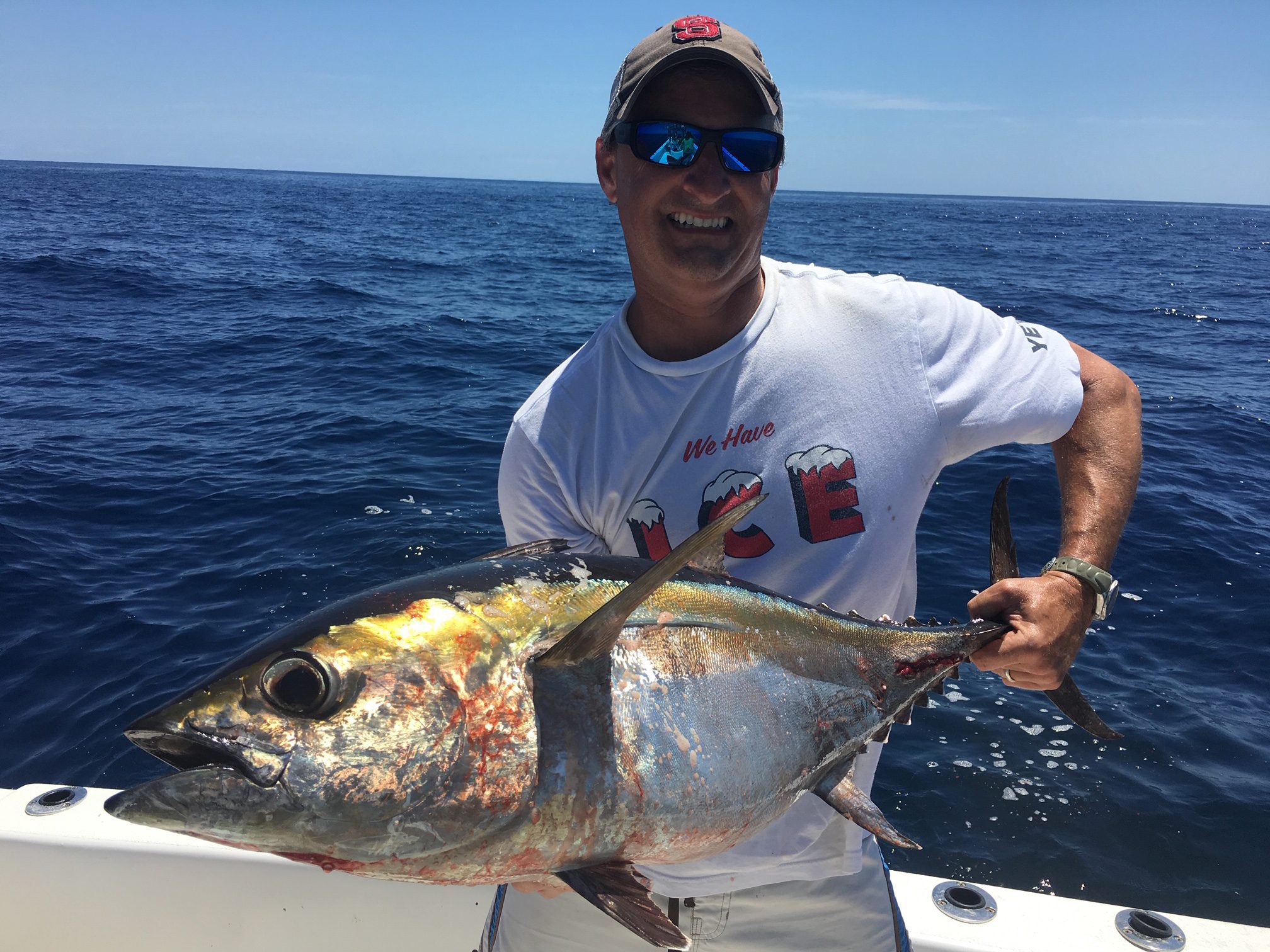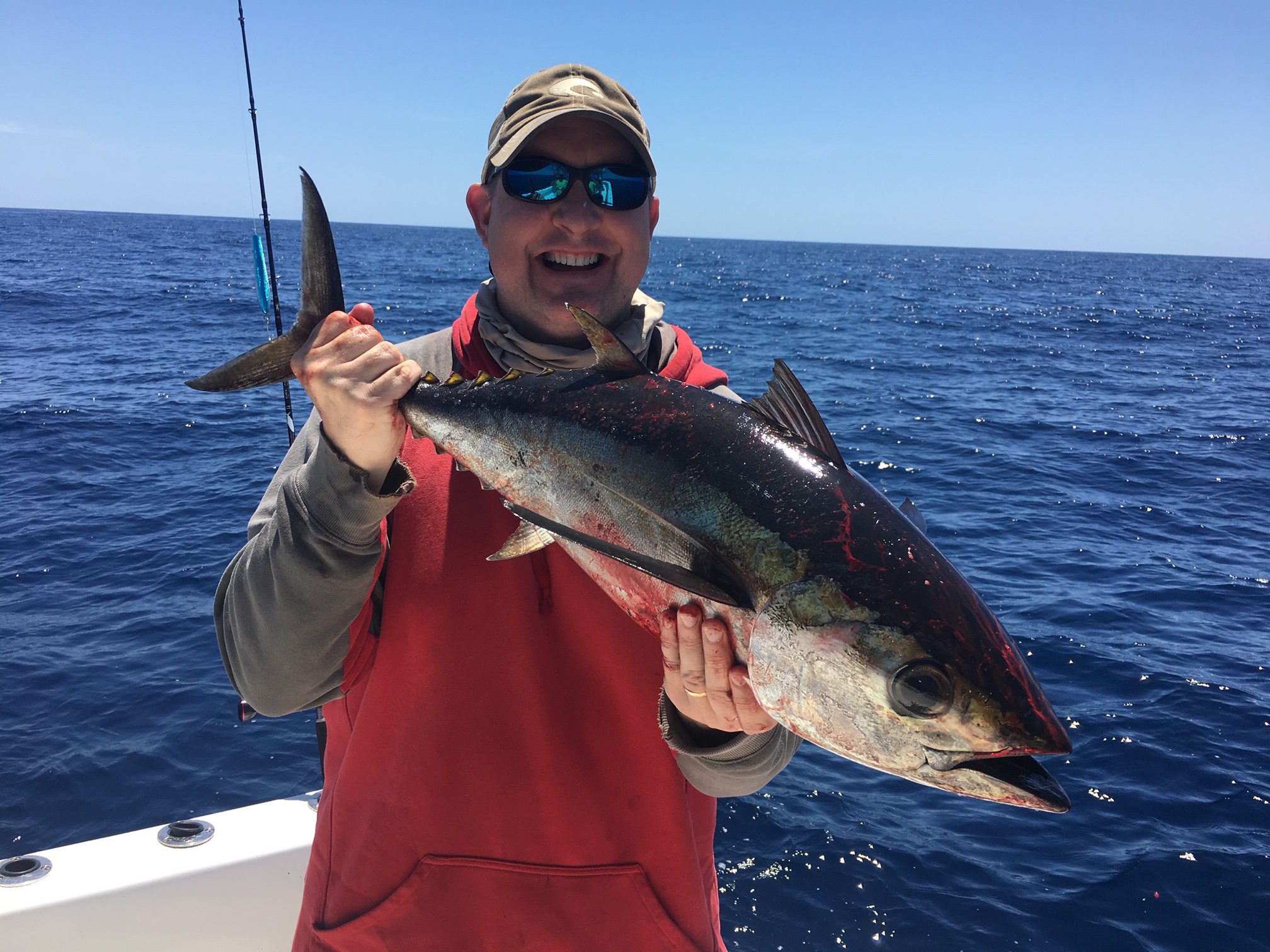Tidelines – May 9, 2019
A good friend is getting ready to move to the ocean-challenged state of Wisconsin, so I thought what better way to send him off than with an offshore trip out of Wrightsville Beach with Capt. Rick Croson of Living Waters Guide Service.
Eric Anderson is my friend that’s moving. His youngest and my oldest play travel soccer together, so we grabbed Adam Tucker, another fellow travel soccer dad, and took off work on a Tuesday to enjoy a run out to the 170 line that featured calm seas, acres of Atlantic bonito starting at about 10 miles, followed by smaller schools of false albacore.
The main plan for the day was to pop and jig for blackfins. We put out the “Indicator,” a Halco Max 130 casting lure thrown back far behind the boat, and before Rick could get a general read of the ledge that morning, our Indicator came fast to blackfin.

Adam Tucker, from Wilmington, with a 30 lb. blackfin that hit a topwater popper in about 350′ of water. He was fishing an offshore ledge with Capt. Rick Croson of Living Waters Guide Service.
Other than losing that initial blackfin (Eric pulled the hook, of course), though, Rick wasn’t marking an overabundance of tuna. Then when one boat reported only amberjacks on the ledge, and another boat a little further offshore was reporting gaffer mahi on a weed line, we decided to start the day trolling for mahi.
Action came almost immediately, and ours, too, were gaffers. The inshore side was the clean edge, and on our second bite we got the visual pleasure of watching our mahi leave the grass to crash a ballyhoo on the short rigger.
Rick was trolling a mix of artificials and ballyhoo, and it was one of his artificial prototypes that attracted what was, or rather what would have been, our biggest mahi of the day.
Rick is currently working with Ilander to utilize the classic Ilander head (typically trolled in front of a ballyhoo or some other natural bait) in a way intended to be used without bait and as a lure only.
Our trip was part of the beta testing process, and the Ilander prototype clearly showed promise, attracting the interest of a big bull. Unfortunately for Adam, the big bull was a smart bull, heading immediately back into the weed line after being hooked. There it collected a ball of grass on its nose, and it was most likely the ball of grass that compromised the hookset integrity (Adam should have better controlled his fish, of course).
We kept bringing in gaffer dolphin, and then came the sailfish. There’s a couple of ways to tell the story of the sailfish, but since this is my article…
The port flat line took off, and at first we thought we had another mahi on the line. I looked at Eric and Adam to see if one of them was going to grab the rod. They didn’t, so I did. Towards the end of an initial run, though, the sailfish finally identified itself with several jumps. The way I remember, I asked Eric and Adam again if one of them wanted to take the rod to fight the sailfish in, and again they both declined.

Eric Anderson, soon to be from Wisconsin, with one of the blackfins he didn’t lose. He caught the blackfin on a topwater popper while fishing the 170 line with Capt. Rick Croson of Living Waters Guide Service.
Eric and Adam, undoubtedly, will tell a different version of the story on the sidelines of the soccer fields, maybe one where I elbowed them each out of the way to grab the rod, or maybe even where I took the rod out of one of their hands, but what isn’t debatable is that after a brilliant show of numerous jumps, both away and close to the boat, Rick leadered what he estimated to be a 60+ lb. sailfish, his first of the 2019 season.
With enough mahi in the box for all of us to have several fish taco family dinners, we put away the trolling gear and headed back to the ledge.
The fish he was marking were anywhere from 100-200’ deep. We dropped a couple of jigs down about four-colors of braid, but when both Adam and Eric came up with amberjacks (yes, suspiciously enough, only the newbie soccer dads came tight to amberjacks, and I somehow didn’t), and then when one of the amberjacks got sharked, we decided to move down-current of the ledge and look for surface signs of blackfins.
There were splashes and crashes of feeding fish, and sometimes even the profiles of blackfins jumping completely out of the water, but the most productive visual for us was flying fish not running from our boat but jumping as a result of something below stirring them up.
“You want a popper that floats high and casts far,” Rick told us. “Make a nice little splash, and then let the popper sit for 6-8 seconds, or even longer, and then splash it again. They’re going to eat it when it’s sitting still.”
The subtle splash of the popper is designed to mimic a flying fish, which re-enters the water fairly quietly. The 6-8 second pause is also to mimic the flying fish, which will sit still after reentry, hoping they didn’t get heard.
All three of us had our turn battling blackfin popper bites, including a hefty 30 lb. fish, and then it was time to head back in.
Capt. Rick Croson, of Living Waters Guide Service, will be targeting blackfins through the month of May, and then he focuses more on the summer mahi, billfish, and bottom fish bite. This summer, though, he’s working his way into a new market. Rick will be focused on taking families with kids on nearshore coastal trips, for such species as spanish mackerel. His boat is perfect for family trips, featuring lots of room in the stern, really high sides for safety, and an incredible stability that will keep even first timers from getting nervous.
If you’d like to charter Rick for an offshore adventure where he might jig, pop, or troll (but most likely do all three), or if you’d like to enjoy having one of the best fishermen around take you just off the beach for a great introductory trip, then give him a call at (910) 620-7709, or look up Living Waters Guide Service on Facebook.
Rick will gladly try to make all the right decisions to put you on plenty of fish. You’re only real concern will be who you decide to bring with you. I suggest bringing along a couple of soccer dads. They will likely lose a fish or two (and maybe even cry a little when fighting the strong-willed tunas and amberjacks), but them losing fish helps you look like a better angler.
